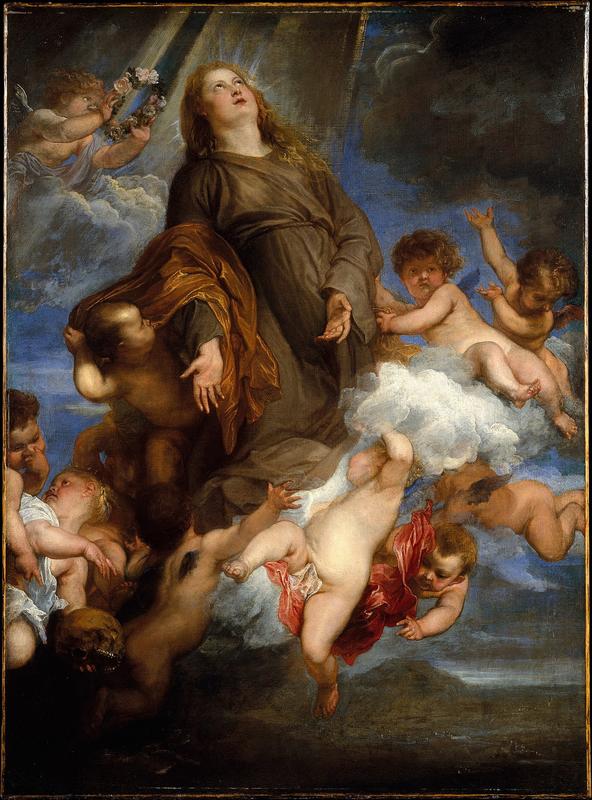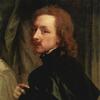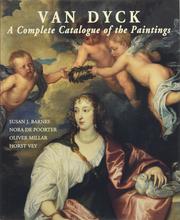More about Saint Rosalie Interceding for the Plague-stricken of Palermo
- All
- Info
- Shop

Contributor
An Italian encyclopedia entry on Santa Rosalia, the title character in van Dyck's Saint Rosalie Interceding for the Plague-stricken of Palermo, classifies her simply as vergine ed eremita, "virgin and hermit," which is a good way to start any resume.
Around nine hundred years ago, Rosalia was born to Roger II of Altavilla, a Norman Lord of Sicily, and Elvira of Castile, the possible granddaughter of al-Mu'tamid Muhammad ibn Abbad Ibn Ismail al-Lakhmi, the last Abbasid ruler of the taifa of Seville. Legend has it that some kind of supernatural messenger appeared to Roger, telling him that Elvira would give birth to a "rose without thorns," completely contradicting the title of the hit song by everyone's favorite hair band, Poison. In any case, Rosalia's "thorns," it turns out, would have been the desire to get married. A guest of Roger a couple of decades later, Baldovino, valiantly saved him from a lion, which makes me think that either the circus was in town or lions once roamed the streets of Palermo. It happens that there were actually wild lions in Greece until 1,000 years earlier. Roger was so grateful that he gave his daughter to Baldovino as a wife, without asking her opinion, because that's how things worked, apparently. Baldovino might have been a handsome and charming dude, might have been wealthy too, but Rosalia was not feeling it, and cut off her long tresses before the wedding, which was her way of saying thanks, but no thanks. She saw her Lord and savior in the mirror, she told the disappointed wedding guests, and now it was time to set off on her own, and go live in a cave in seclusion, where she spent the rest of her days.
Every year in July, Palermo holds the Festino, which has been "as fixed as Christmas" for locals, ever since the year that van Dyck produced this work. Because van Dyck's short working vacation in Palermo coincided with the appearance of the remains of Rosalia and her canonization, the painter took on the challenging task of building, from scratch, an iconography for her. Part of her job was to fight the plague, from which van Dyck fled a few months later. He used the elements that were on hand for his iconography, such as the cherub holding a wreath of roses, a motif that also appears in his Madonna images. This work has so much in common with the Madonna, and Rosalia is still so specific to Sicily, that, during its first year in business, The Met misidentified this work as an "Assumption of the Virgin." During the COVID-19 pandemic, Jason Farago visited and wrote about this painting at the Met, in a museum empty of other visitors. He notes that are four other extant van Dyck Rosalias: "two in Europe (at the Prado in Madrid and Apsley House in London), and two in the United States: one in the Menil Collection in Houston, another at the Museo de Arte de Ponce, Puerto Rico."
Sometimes, to make it talk, you gotta shoot neutrons at a painting: a beam of neutrons causes the emission of gamma rays from the elements in the pigments in this work, which allows you to discover the composition of the elements in a manner similar to x-radiography. Such analysis of this work shows that, before he painted Rosalia, van Dyck had done a self-portrait sketch in bone black oil paint, before flipping the canvas over and painting over it.
Sources
- Farago, Jason. "The Saint Who Stopped an Epidemic Is on Lockdown at the Met." The New York Times, Mar. 26, 2020, https://www.nytimes.com/2020/03/26/arts/design/van-dyck-metropolitan-mu….
- "IL 379° FESTINO DI SANTA ROSALIA Dal 10 al 15 luglio 2002 i festeggiamenti in onore della Patrona di Palermo." Feste di Sicilia, http://www.festedisicilia.it/santa_rosalia3.htm.
- "La Storia... in breve." Palermo Web, http://www.palermoweb.com/santarosalia/storiabreve.htm.
- Liedtke, Walter A. Flemish Paintings in the Metropolitan Museum of Art, Volume 1. New York: Metropolitan Museum of Art, 1984.
- "Santa Rosalia di Van Dyck, quarantena al Met." Ait Sicilia, Mar. 30, 2020, https://www.ansa.it/sicilia/notizie/2020/03/30/santa-rosalia-di-van-dyc…
- Taft, W. Stanley Jr., and James W. Mayer. The Science of Paintings. New York: Springer Science & Business Media, 2001.
- Tondo, Lorenzo. "Palermo pins hopes on patron saint to rid Italy of coronavirus." The Guardian, Mar. 13, 2020, https://www.theguardian.com/world/2020/mar/13/palermo-pins-hopes-patron….
Featured Content
Here is what Wikipedia says about Saint Rosalie Interceding for the Plague-stricken of Palermo
Saint Rosalie Interceding for the Plague-stricken of Palermo is a painting of 1624 by Anthony van Dyck, in the Metropolitan Museum of Art in New York since 1871.
The painting depicts Saint Rosalia, the patron saint of Palermo, interceding for the city during an outbreak of the plague. In the background can be seen the port of Palermo and Monte Pellegrino.
The painting was one of six of Saint Rosalia produced in Palermo by van Dyck in the late summer of 1624 and early 1625, when the city was quarantined. He returned to the subject in 1629 with Coronation of Saint Rosalia (Vienna) and Saint Rosalia Interceding for the City of Palermo (Ponce, Puerto Rico).
The work is currently (2020) on view at the Metropolitan Museum of Art. It was an early acquisition by the institution, whose curators initially mistook it for an Assumption of the Virgin. An undated but probably autograph copy of the work is now in the Alte Pinakothek in Munich.
Check out the full Wikipedia article about Saint Rosalie Interceding for the Plague-stricken of Palermo













